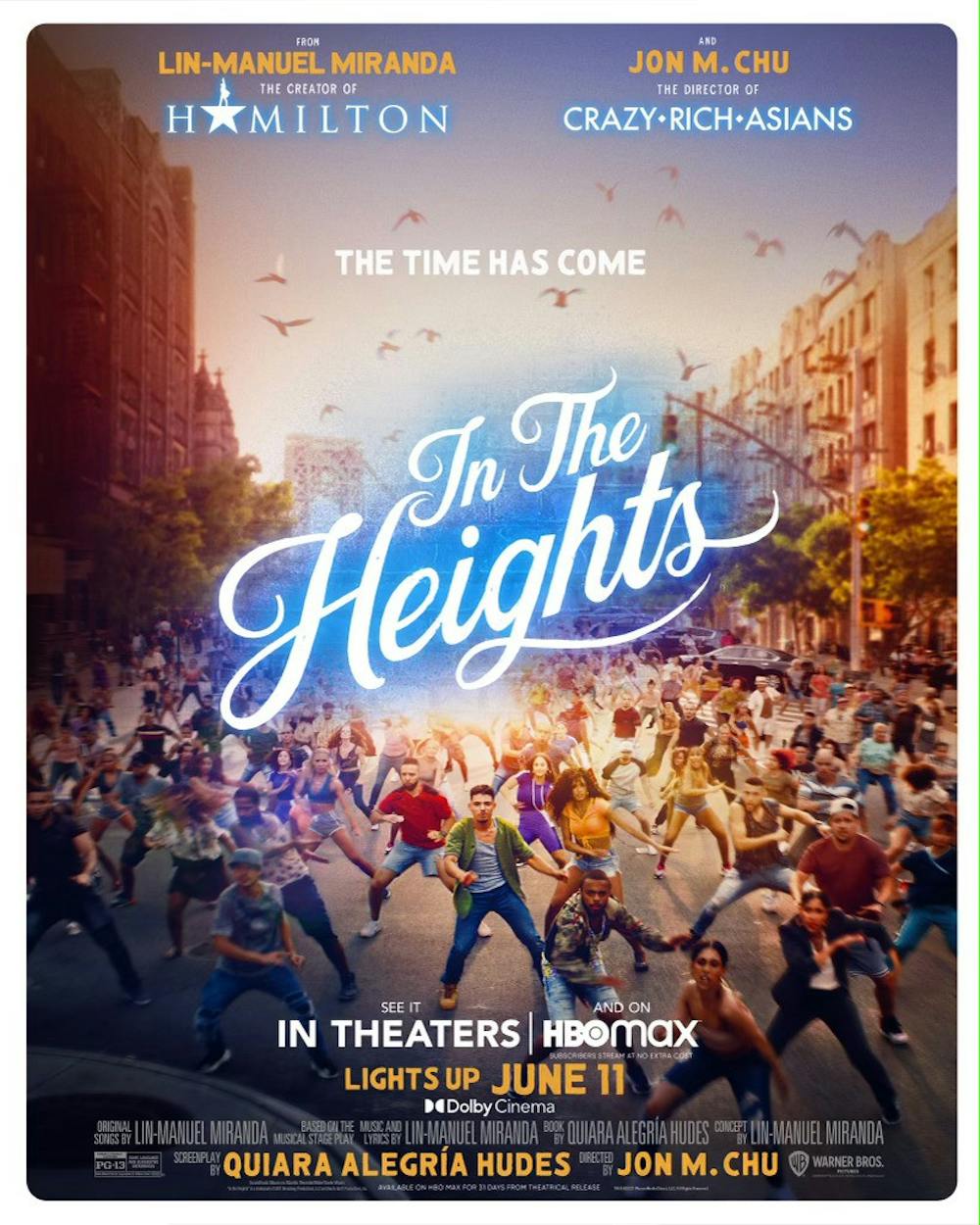As a self-proclaimed “Hamilfan,” or fan of the smash-hit musical “Hamilton,” it would be an understatement to say I was excited for Lin-Manuel Miranda’s newest movie musical adaptation, “In the Heights” (ITH).
The story focuses on protagonist Usnavi de la Vega, a small bodega owner in Washington Heights, New York, as he dreams of a better life for himself and his friends.
Before the title card flashes onto the screen 16 minutes into the show, most of the side characters are introduced: Sonny de la Vega, Usnavi’s cousin and bodega coworker; Benny, Usnavi’s best friend; Vanessa, the girl with big dreams who wants out of the barrio (and Usnavi’s love interest); Nina Rosario, the girl who got out of the barrio to go to Stanford University (Benny’s love interest); and “Abuela” Claudia, the matriarch of the neighborhood.
Despite the onslaught of different characters right from the beginning, it’s easy to keep track of everyone because they all want such different things: some desperately want to leave Washington Heights, some want to stay forever, and some have left and returned, disappointed in the world beyond their block.
This film does not hit theaters and streaming platforms until June 11. Because of my involvement in various Latinx college groups, though, I was lucky enough to enjoy an advanced screening (complete with a post-movie panel featuring Miranda and other cast members).
The drought of impressive movie musicals in recent years kept my expectations low. The musical scene has looked like “Cats,” “The Prom” (don’t even get me started on this one) and various remakes, sequels and biopics (like “Bohemian Rhapsody” and “Rocketman”). Even movies like “La La Land” and “The Greatest Showman” were disappointing, especially in the way they captured the worst part of musicals: the cheesiness.
But ITH uses its cheesiness to create one of the most authentic musicals I’ve ever seen.
ITH concocts a perfect mixture of realistic and fantastical elements. Unlike “La La Land,” which obnoxiously shoves its beautiful, outlandish scenes down the audience's throats, ITH unobtrusively invites the audience into an alternate reality.
In one scene, the characters dance and sing while finger-drawing objects into the air which materialize into things they can actually hold. It’s a brilliant scene where the absurdity is obvious and the movie isn’t taking itself too seriously as a musical, something “La La Land” does to a fault.
More than the cinematography, which is stunning, the characters and stories are painfully relatable.
Myself and many college students are Nina Rosario: the girl who got out.
Two lines from her return-to-the-barrio song, “Breathe,” describe the progressively intrusive thoughts of many low-income, first-generation or immigrant students:
Enjoy what you're reading?
Signup for our newsletter
“I am the one who made it out.”
“I know that I’m letting you down.”
I am a low-income child of an immigrant father and parents who can only dream of getting more than associate's degrees. I couldn’t be prouder to be their daughter – they make sure I always have what I need and make education such an important role in my life.
And that’s why I relate so much to Nina.
Like her, “I got every scholarship, saved every dollar” and made all the grades, yet sometimes I feel like “the biggest disappointment.” Especially at Miami University, a school where the median income of students (from a study done in 2013) is $119,000, it’s easy to feel out of place as a low-income student.
But I’m also a very white-passing Latinx woman, something I do not take for granted. One line in the film, from the Cuban Abuela Claudia, struck a chord in me:
“We had to assert our dignity in small ways.”
It’s like a lightbulb clicked in my head. My Colombian father always asks my rural-Ohio mother and myself how to say certain words, and I never understood the significance of his asking. But this line really made my privilege show: I’ve never had to worry about an accent. I’ve never had to worry about being “uncodumented.” I’ve never had to worry that the country I’ve lived in for 30+ years, or the country I was brought to as a child, wouldn’t accept me.
And if you don’t live with those problems either, you should check out this film.
It’s also refreshing to see genuine representation of Latino-American people in Hollywood, with no whitewashing (although Anthony Ramos, who plays Dominican Usnavi, is actually Puerto Rican). In contrast, “West Side Story,” one of the most influential depictions of Latinx people and arguably one of the most famous musicals in cinematic history, has come under fire for its racism and stereotyping of Puerto Ricans (and Americans).
I’d also be remiss if I didn’t mention the obvious parallels between this film and Spike Lee’s 1989 “Do the Right Thing” (DTRT).
First of all, they’re both set in unofficially racially segregated neighborhoods in New York. In DTRT, the neighborhood is Bedford-Stuyvesant, less than an hour from Manhattan’s Washington Heights.
Both stories also take place in under three days during a heat wave, which results in rising tensions among the characters. DTRT’s heat undoubtedly culminates in a more disturbing tragedy than does ITH’s.
Between eerily similar characters and small references throughout (open fire hydrants appear, albeit with different symbolism, in each show), both movies comment on the way America treats those who are racially or ethnically diverse.
The fast-pace editing, creative cinematography, elaborate and glamorous group dances and twist ending all come together to produce a masterpiece heads above those in the contemporary musical world.
Plus, Anthony Ramos is pretty easy on the eyes.
Rating: 9/10




